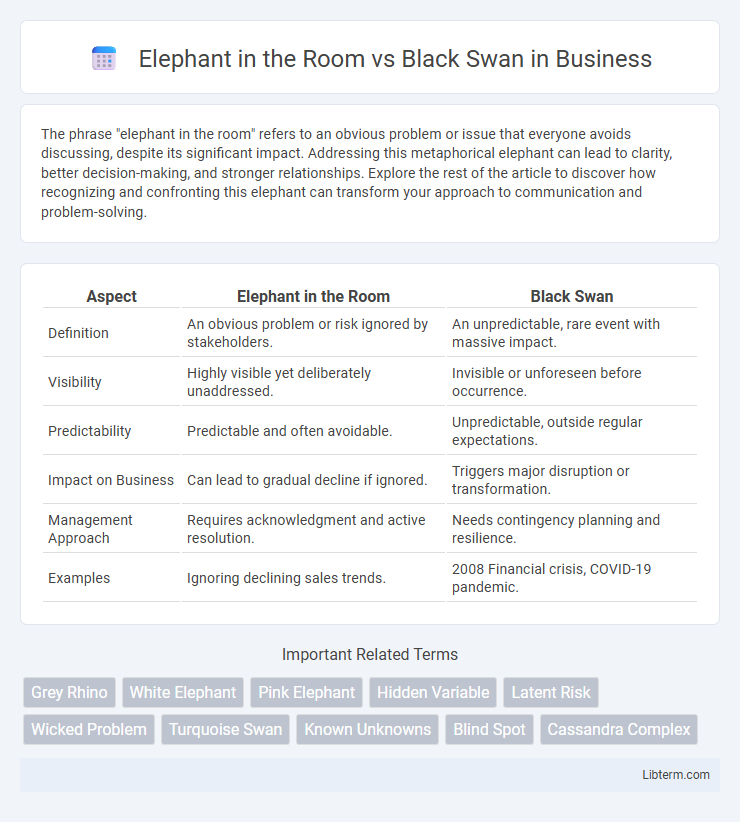The phrase "elephant in the room" refers to an obvious problem or issue that everyone avoids discussing, despite its significant impact. Addressing this metaphorical elephant can lead to clarity, better decision-making, and stronger relationships. Explore the rest of the article to discover how recognizing and confronting this elephant can transform your approach to communication and problem-solving.
Table of Comparison
| Aspect | Elephant in the Room | Black Swan |
|---|---|---|
| Definition | An obvious problem or risk ignored by stakeholders. | An unpredictable, rare event with massive impact. |
| Visibility | Highly visible yet deliberately unaddressed. | Invisible or unforeseen before occurrence. |
| Predictability | Predictable and often avoidable. | Unpredictable, outside regular expectations. |
| Impact on Business | Can lead to gradual decline if ignored. | Triggers major disruption or transformation. |
| Management Approach | Requires acknowledgment and active resolution. | Needs contingency planning and resilience. |
| Examples | Ignoring declining sales trends. | 2008 Financial crisis, COVID-19 pandemic. |
Understanding the “Elephant in the Room” Metaphor
The "Elephant in the Room" metaphor highlights an obvious problem or risk that everyone is aware of but deliberately ignores, contrasting sharply with a "Black Swan," which represents an unpredictable, rare event with significant impact. Understanding this metaphor involves recognizing the tendency to avoid discussing critical issues due to discomfort or fear, despite their evident presence and potential consequences. Addressing the "Elephant in the Room" is crucial for effective decision-making and risk management, promoting transparency and proactive solutions.
Defining the “Black Swan” Phenomenon
The "Black Swan" phenomenon refers to highly improbable and unpredictable events with massive impact, such as the 2008 financial crisis or the COVID-19 pandemic. Unlike the "Elephant in the Room," which involves obvious issues ignored by people, Black Swan events remain hidden until they occur. These rare occurrences challenge conventional risk assessment by highlighting the limits of foresight and reliance on historical data.
Origins and Evolution of Each Term
The term "Elephant in the Room" originated in the mid-20th century, describing an obvious problem or truth that is being ignored, often attributed to a metaphor popularized in the 1950s and 1960s. "Black Swan," coined by Nassim Nicholas Taleb in 2007, refers to rare, unpredictable events with significant impact, drawing from the historical assumption that all swans were white until black swans were discovered in Australia. Both terms have evolved to capture different aspects of human perception: the former highlights conscious avoidance of realities, while the latter emphasizes unpredictability and the limits of knowledge in risk assessment.
Recognizing Elephants: Obvious but Ignored Issues
Elephant in the Room refers to large, obvious problems that everyone is aware of but deliberately avoids discussing, often due to discomfort or fear of confrontation. Recognizing these elephants requires a keen awareness of unspoken issues that impact decisions and dynamics within organizations or societies. Unlike Black Swan events, which are rare and unpredictable, elephants are conspicuous yet persistently ignored, making acknowledgment the first step toward resolution.
Spotting Black Swans: Rare and Unpredictable Events
Spotting Black Swans requires recognizing rare, unpredictable events with massive impact that often lie outside standard expectations, contrasting with the Elephant in the Room, which represents obvious problems ignored despite being evident. Black Swan events challenge traditional risk assessment models due to their extreme rarity and high consequences, making proactive identification complex but critical. Understanding the characteristics of Black Swans enhances strategic planning and resilience by incorporating unknown uncertainties rather than overlooking them like the Elephant in the Room.
Key Differences Between Elephant in the Room and Black Swan
The key differences between an Elephant in the Room and a Black Swan lie in their visibility and impact predictability; the Elephant in the Room represents an obvious issue deliberately ignored by people, while a Black Swan signifies an unpredictable, rare event with massive consequences. Elephants in the Room are known problems that stakeholders avoid addressing, whereas Black Swans emerge unexpectedly from incomplete knowledge or unforeseen variables. Understanding these distinctions is crucial for effective risk management and decision-making in business and strategic contexts.
Psychological Impact on Decision Makers
The psychological impact of the "Elephant in the Room" phenomenon creates cognitive dissonance and avoidance behaviors among decision makers, leading to denial of obvious problems that hinder effective resolution. In contrast, the "Black Swan" effect triggers shock and retrospective rationalization, causing decision makers to underestimate the unpredictability of rare, high-impact events. Both phenomena impair risk assessment and strategic planning by distorting perception and fostering biases such as confirmation bias and overconfidence.
Real-World Examples: Elephants vs. Black Swans
Elephants in the room refer to obvious problems or risks everyone ignores, such as climate change debates where its impacts are clear but often unaddressed. Black swans represent rare, unpredictable events with massive impact, exemplified by the 2008 financial crisis triggered by unforeseen market collapses. While elephants require acknowledgment and proactive management, black swans demand resilience and flexibility due to their unforeseeable nature.
Addressing Both in Risk Management Strategies
Addressing both Elephant in the Room and Black Swan events in risk management strategies requires identifying obvious yet ignored risks alongside rare, unpredictable occurrences with extreme impact. Integrating continuous risk assessment processes and scenario planning helps organizations recognize significant, unaddressed vulnerabilities while preparing adaptive responses for unexpected crises. Leveraging data analytics and fostering a culture of open communication enhances the detection of visible risks and strengthens resilience against unforeseen disruptions.
Conclusion: Integrating Awareness into Leadership and Planning
Effective leadership integrates awareness of both the Elephant in the Room and Black Swan events to enhance decision-making resilience. Addressing obvious yet ignored issues prevents blind spots, while preparing for rare, unpredictable disruptions ensures adaptability. This dual focus fosters proactive strategies and robust organizational agility in dynamic environments.
Elephant in the Room Infographic

 libterm.com
libterm.com